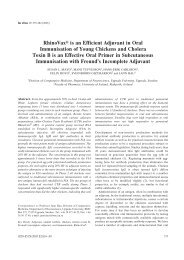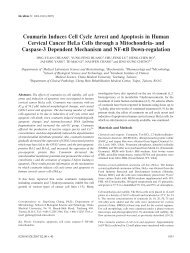Leukocyte and Endothelial Cell Adhesion Molecules in Inflammation ...
Leukocyte and Endothelial Cell Adhesion Molecules in Inflammation ...
Leukocyte and Endothelial Cell Adhesion Molecules in Inflammation ...
Create successful ePaper yourself
Turn your PDF publications into a flip-book with our unique Google optimized e-Paper software.
Golias et al: <strong>Adhesion</strong> <strong>Molecules</strong> <strong>in</strong> Inflammatory Heart Disease (Review)<br />
Myocarditis. Myocarditis is one of the most challeng<strong>in</strong>g<br />
diagnoses <strong>in</strong> cardiology. The entity is rarely recognised, the<br />
pathophysiology is poorly understood, there is no commonly<br />
accepted diagnostic gold st<strong>and</strong>ard <strong>and</strong> all current treatment<br />
is controversial. Primary myocarditis is presumed to be due<br />
to either an acute viral <strong>in</strong>fection (e.g. coxsackie,<br />
cytomegalovirus, adenovirus, <strong>in</strong>fluenza, rubella virus) or a<br />
postviral autoimmune response. Secondary myocarditis is<br />
myocardial <strong>in</strong>flammation caused by a specific pathogen<br />
<strong>in</strong>clud<strong>in</strong>g bacteria, protozoa, rickettsia, spirochetes, fungi,<br />
drugs, chemicals, physical agents or other <strong>in</strong>flammatory<br />
diseases such as lupus erythematosus (15). Briefly, <strong>in</strong> viral<br />
myocarditis, the virus enters the body through the<br />
respiratory or gastro<strong>in</strong>test<strong>in</strong>al tract stimulat<strong>in</strong>g a systemic<br />
immune response. Immune response cells, such as dentritic<br />
cells <strong>and</strong> macrophages release cytok<strong>in</strong>es, <strong>in</strong>terleuk<strong>in</strong>s,<br />
perfor<strong>in</strong>, reactive oxygen species, tumour necrosis factor<br />
<strong>and</strong> regulatory growth factors. Once these products activate<br />
nuclear factor B, the production of cytok<strong>in</strong>es, ICAM, <strong>and</strong><br />
<strong>in</strong>ducible nitric oxide is <strong>in</strong>duced. In parallel, antigenpresent<strong>in</strong>g<br />
cells express<strong>in</strong>g major histocompatibility complex<br />
<strong>and</strong> associated with co-receptors CD 40 <strong>and</strong> ICAM couple<br />
with <strong>in</strong>fected myocytes display<strong>in</strong>g antigen (epitope) on their<br />
surface (105-107). This <strong>in</strong>volvement of CAMs <strong>in</strong> the<br />
pathophysiology of myocarditis is supported <strong>and</strong> further<br />
enhanced by several studies found <strong>in</strong> the literature.<br />
Specifically, cell-mediated autoimmunity has been<br />
strongly implicated <strong>in</strong> the pathogenesis of the myocardial<br />
cell damage <strong>in</strong>volved <strong>in</strong> viral myocarditis. To <strong>in</strong>vestigate the<br />
cellular <strong>and</strong> molecular bases of both target cells <strong>and</strong> effector<br />
cells for cell-mediated cytotoxicity <strong>in</strong>volved <strong>in</strong> viral<br />
myocarditis, scientists attempted to exam<strong>in</strong>e the expression<br />
of major histocompatibility complex (MHC) antigens <strong>and</strong><br />
ICAM-1 <strong>in</strong> myocardial cells of a mur<strong>in</strong>e model of viral<br />
myocarditis <strong>and</strong> <strong>in</strong> patients with acute myocarditis <strong>and</strong><br />
dilated cardiomyopathy with rather <strong>in</strong>terest<strong>in</strong>g results. Both<br />
MHC <strong>and</strong> <strong>in</strong>terest<strong>in</strong>gly ICAM-1 were clearly expressed <strong>in</strong><br />
the hearts of these patients (108, 109). In general, the<br />
importance of VCAM-1 <strong>and</strong> ICAM-1 <strong>in</strong> controll<strong>in</strong>g cell<br />
adhesion <strong>and</strong> migration is well established (110). Moreover,<br />
studies have clearly suggested that the elevated levels of<br />
ICAM-1 <strong>and</strong> VCAM-1 are often found <strong>in</strong> the serum of<br />
patients with non-ischemic heart failure. These raised serum<br />
levels correlate with <strong>in</strong>flammatory <strong>in</strong>filtrates <strong>in</strong> the myocardial<br />
tissue (111). Expression of ICAM-1 <strong>and</strong> VCAM-1 on<br />
endothelial cells of capillaries <strong>in</strong> myocardium are <strong>in</strong>creased<br />
<strong>in</strong> patients suffer<strong>in</strong>g from eos<strong>in</strong>ophilic myocarditis or<br />
coxsackie virus B3 acute myocarditis (108, 111, 112). In this<br />
context, it has been shown that expression of endothelial<br />
ICAM-1 is a prerequisite for target organ recognition by<br />
autoreactive T-cells (105). In addition, VCAM-1 expression<br />
has been demonstrated <strong>in</strong> mice that developed myos<strong>in</strong><strong>in</strong>duced<br />
CD4-mediated myocarditis (113, 114). Consistently,<br />
up-regulation of VCAM-1 expression has been observed<br />
follow<strong>in</strong>g early acute Trypanosoma cruzi <strong>in</strong>fection (115,116).<br />
Relatively recently, <strong>in</strong> the literature it was revealed that<br />
dur<strong>in</strong>g chronic T. cruzi <strong>in</strong>fection, a remarkable <strong>in</strong>crease <strong>in</strong><br />
the expression of VCAM-1 was observed on cardiac vascular<br />
endothelium (117). The same phenomenon was also found<br />
<strong>in</strong> coxsackie virus B3-<strong>in</strong>duced myocarditis (108, 117). Most<br />
importantly, it seems that ICAM-1 <strong>and</strong> VCAM-1 blood<br />
vessels associated with CD8 + <strong>in</strong>filtrat<strong>in</strong>g T-cells were also<br />
detected <strong>in</strong> the cardiac tissue of chagasic patients with<br />
severe cardiomyopathy (118). It is more than evident that<br />
the participation of CAMs <strong>in</strong> the establishment of<br />
autoimmune <strong>and</strong> <strong>in</strong>fectious myocarditis is an important<br />
matter of <strong>in</strong>vestigation, provid<strong>in</strong>g a broad wide field of<br />
<strong>in</strong>vestigation which may have promis<strong>in</strong>g diagnostic <strong>and</strong><br />
therapeutic implications regard<strong>in</strong>g myocarditis <strong>in</strong> the future.<br />
Pericarditis. Although it is evident from general knowledge<br />
that CAMs should have a role <strong>in</strong> the molecular pathology<br />
of <strong>in</strong>flammatory pericarditis, there is still no direct proof <strong>in</strong><br />
the literature concern<strong>in</strong>g this issue. It is more than likely<br />
that future studies are or will be conducted towards<br />
underst<strong>and</strong><strong>in</strong>g CAM <strong>in</strong>volvement <strong>in</strong> the development of<br />
<strong>in</strong>flammatory pericarditis.<br />
Conclusion<br />
Scientific evidence is rapidly accumulat<strong>in</strong>g to support the<br />
view that leukocyte <strong>and</strong> endothelial cell-associated CAMs<br />
are critical participants <strong>in</strong> the vascular dysfunction <strong>and</strong> tissue<br />
<strong>in</strong>jury that is associated with a wide variety of <strong>in</strong>flammatory<br />
<strong>and</strong> cardiovascular diseases. Advances <strong>in</strong> this field have<br />
largely resulted from the marriage of novel immunological<br />
<strong>and</strong> molecular biological approaches to traditional<br />
experimental strategies <strong>in</strong> cardiovascular physiology. This<br />
effort has led to a new appreciation of the difficulties <strong>in</strong><br />
dist<strong>in</strong>guish<strong>in</strong>g cardiovascular from <strong>in</strong>flammatory diseases<br />
<strong>and</strong> provides hope that therapeutic <strong>in</strong>terventions <strong>and</strong> new<br />
diagnostic <strong>and</strong> prognostic perspectives target<strong>in</strong>g CAM may<br />
be of some benefit <strong>in</strong> the treatment of <strong>in</strong>flammatory as well<br />
as cardiovascular diseases.<br />
References<br />
1 Carreno MP, Rousseau Y <strong>and</strong> Haeffner-Cavaillon N: <strong>Cell</strong><br />
adhesion molecules <strong>and</strong> the immune system. Allerg Immunol<br />
(Paris) 27(4): 106-110, 1995.<br />
2 Hillis GS <strong>and</strong> MacLeod AM: Integr<strong>in</strong>s <strong>and</strong> disease. Cl<strong>in</strong> Sci<br />
(Lond) 91(6): 639-650, 1996.<br />
3 Mareckova Z, Heller S <strong>and</strong> Horky K: <strong>Cell</strong> adhesion molecules<br />
<strong>and</strong> their role <strong>in</strong> pathophysiologic processes. Vnitr Lek 45(1):<br />
46-50, 1999.<br />
4 Rojas AI <strong>and</strong> Ahmed AR: <strong>Adhesion</strong> receptors <strong>in</strong> health <strong>and</strong><br />
disease. Crit Rev Oral Biol Med 10(3): 337- 358, 1999.<br />
765






